Gazanias are a mixed bag, with bright blousy flowers that can be either annual or half-hard perennials. While they tend to take a lot of work to get right, they are well worth the effort for the dramatic floral display in summer that can often last well into autumn.
We’ve put together a comprehensive guide for how to grow Gazanias at home, including details on how to take care of these beautifully bonkers plants all year round.
More...
Family: | Asteraceae |
|---|---|
Genus: | Gazania |
Common Names: | African Daisy |
Location: | Outdoor |
Type: | Herbaceous perennial, or tender annual |
Growth: | 15cm x 30cm (H x W) |
Sun requirements: | Full sun |
Foliage Colour: | Green |
Flower Colour: | Mixed (yellow, orange, white, pink, purple) |
Flowering: | Spring-summer |
Fruit: | None |
Maintenance level: | Medium |
Poisonous for pets: | Non-toxic to cats and dogs |
What is a Gazania?
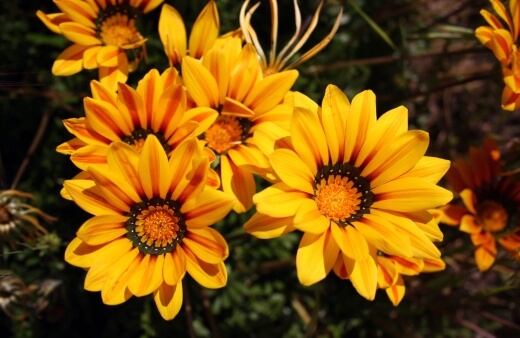
Gazania, also called the African Daisy, is a brightly flowering herbaceous border and bedding plant, ideal for Australian gardens. They are a member of the Asteraceae family, which includes everything from common daisies and Bidens to vegetables like artichokes and lettuce, and is the second largest plant family on the planet.
The diversity of the wider family is well presented with Gazania, which come in both perennial and annual forms and thrive in high temperature, high moisture environments.
Their large flowers resemble daisies, with tight symmetrical petals surrounding a bright yellow pollen-rich centre. Their key difference from common daisies is their colourful petals.
Most natural forms are yellow, with splashes of orange leading to a rusty centre, often decorated with regular white or black flecks.
Gazania’s Natural Habitat
Gazanias are native to Southern Africa, thriving in dense exposed meadows where they grow best in free-draining poor soil, making them a cost-effective plant that’s well suited to most Australian gardens.
They like full sun, and many species trail to create thick groundcover, though most cultivars differ from the naturally occurring species through highly selective breeding.
Gazanias to Grow in Your Garden
Gazania are varied, but each of their key variations can be traced back to an origin species. There are just 18 species of Gazania in the wild, but hundreds of cultivars that have been bred by botanists and gardeners to select for beauty, hardiness, and in some cases, evergreen structure.
Below, we’ve compiled a list of the best Gazania species to grow at home, but first, let’s look at some of the basic species identifiers:
Gazania caespitosa
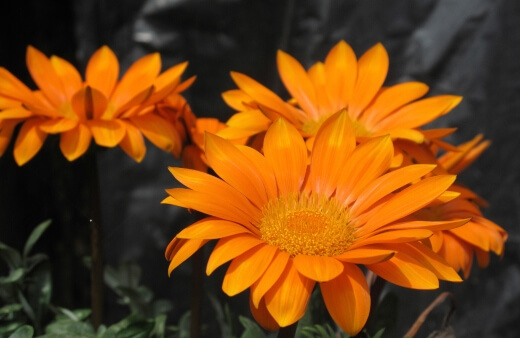
This is a typical gazania, with long narrow leaves forming a dense mat of foliage beneath bright yellow flowers. They thrive on poor soil and flower best in hot dry conditions, though are rarely available in a pure species form for gardens.
Gazania ciliaris

Source: lifestyleseeds.co.za
G. ciliaris have a loose, evergreen structure, and sparse bright-yellow flowers with wide petals and deep brown colouration in the centre of each flower.
Gazania heterochaeta
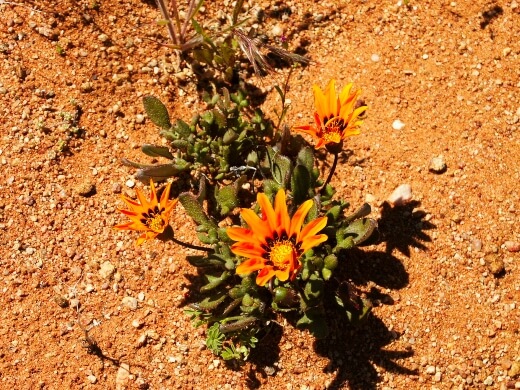
Source: en.wikipedia.org


Get Your Free Guide:
Master Growing Australian Natives eBook
A Must Have Complete Guide for Every Australian Garden
Get Your Free Guide:
Master Growing Australian Natives eBook
A Must Have Complete Guide for Every Australian Garden
This species is commonly found growing in rock formations on any loose grit it can hold onto. They are incredibly tough plants, with rounded petals and plump round leaves that are better adapted to sudden heavy rainfall.
Gazania jurineifolia
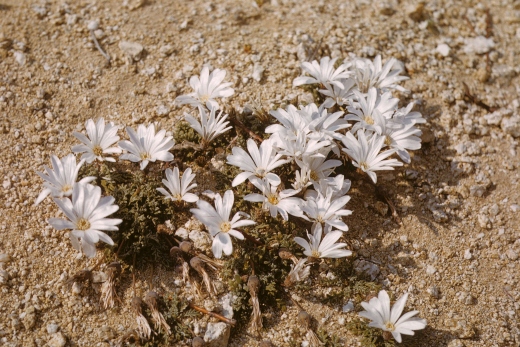
Source: eol.org
G. jurineifolia are an exceptionally interesting species of Gazania. Their flowers tend to be white with green or purple centres, though some cultivars are an even yellow.
The easiest way to identify them is through their spiky, oak-shaped leaves, which are pale and often.
Gazania krebsiana
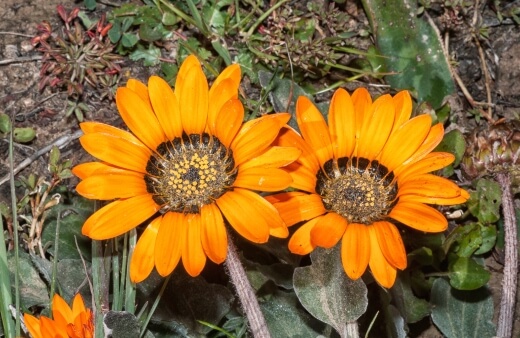
Is a low-growing species that grows in open meadows, often flowering at its best following wildfires thanks to the clear ground. The yellow flowers are simple, and can completely cover the foliage in hot summers.
Gazania lichtensteinii

This variety is also called the yellow calendula but bears no direct relationship to calendula. Their lemon-yellow flowers are neatly formed and do best on sandy soils with occasional heavy watering.
Gazania leiopoda

Source: inaturalist.org
Know as Magnificent Gazania, are available in most garden centres in late spring and have quite a long flowering season. Their silvery foliage gives no indication of the fiery orange blooms that follow.
Gazania linearis
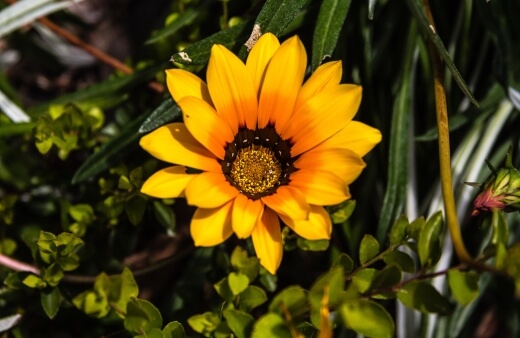
G. linearis is perhaps better known as the treasure flower. The long, grass-like foliage grows in clumps and spreads through loose soils, making it a cost-effective ground cover plant, with airy yellow blooms in summer.
The upper surface of its leaves is pastel green, with a fluffy white texture underneath.
Gazania maritima
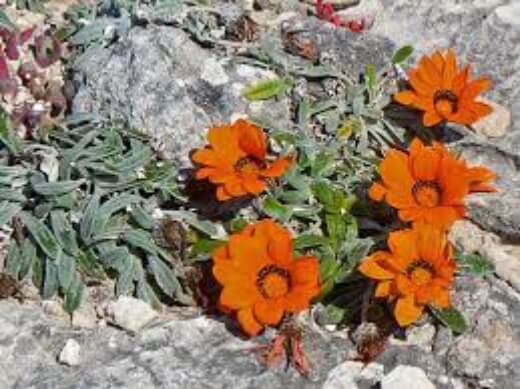
Source: africanplants.senckenberg.de
As the name suggests, grows best in coastal locations, and is perfectly suited to strong, salty winds. The low growing form and strong stems ensure that flowers are lost to the wind.
Its fluffy leaf surface protects it from salt exposure withholding in moisture that would otherwise be dried out. Flowers can be yellow or orange depending on the cultivar.
Gazania othonnites
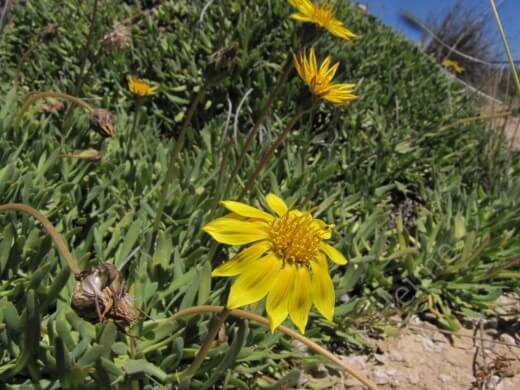
Source: casabio.org
This species is ideal for coastal and exposed gardens, with a low-growing form that helps to hold loose gravelly soil together, reducing erosion and adding interest all year round.
This perennial Gazania has irregular yellow flowers that dot around the plant clumps throughout summer, rather than a single short-lived display.
Gazania pectinata
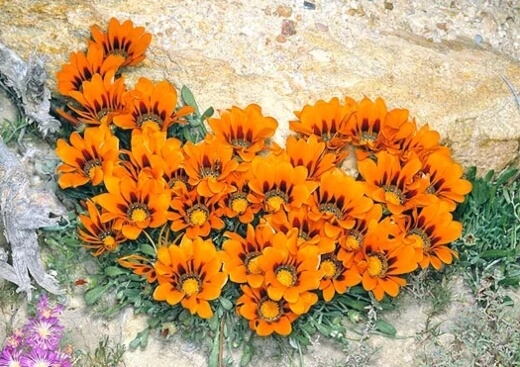
Source: monaconatureencyclopedia.com
G. pectinata grow all over Southern Africa and are widely used as coastal and meadow plants in equal measure. They are highly adaptable and will cope on most soils.
Gazania pinnata
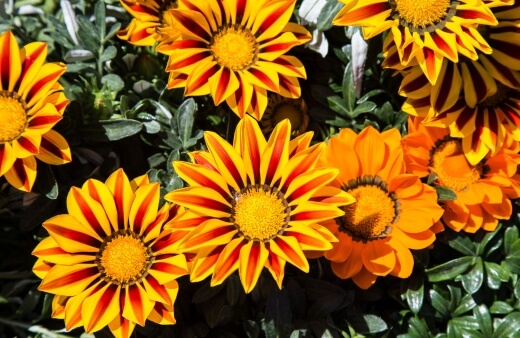
This species is used to breed most common garden cultivars, with long flowering stems that shoot out from dense clusters of grey-green foliage.
Each plant is relatively small but they can spread over the years into a dense cluster of small plants, each with flowers that can cover twice the diameter of the plant below.
Gazania rigens
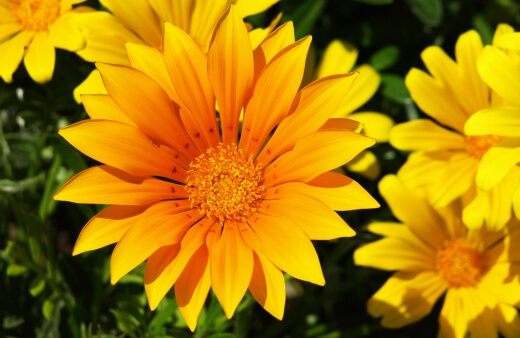
Is a simple gazania that is often sold as an annual, but if grown in full sun, and kept dry through winter it will return every year in Australian gardens.
Their flecked brown centres pair beautifully with their emerald green leaves and sunshine-yellow petals.
Gazania rigida

G. rigida are one of the few Gazania species with reliably orange flows. Their centres are mesmerizingly beautiful up close, with rich patterns of blacks, browns and reds, flicked with white and yellow.
Gazania serrata
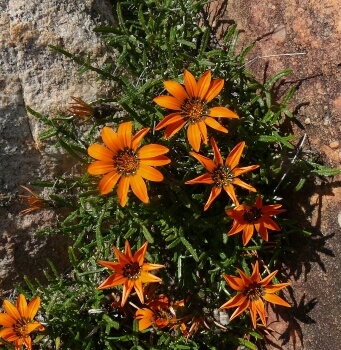
Source: en.wikipedia.org
Serrata’s short flower stems make them ideal ground cover plants, with half-hardy evergreen foliage, which continues to crowd out weeds right through winter and early spring, helping to create a simple, low-maintenance garden.
Its orange blooms reach out just past the foliage, so add interest without interrupting the structure.
Gazania tenuifolia

Source: inaturalist.ca
This is a very well-named species, with tenuous, crawling stems, that hold loosely clustered pinnate leaves, easily rooting itself into dry soil and great for cuttings.
Tenuifolia tends to flower around the edge of the plant, so makes a great addition to hanging baskets, helped further by its ability to withstand drought.
Gazania thermalis
This is a rare species only found on geothermal wetlands in Namibia. It relies on those unique conditions to grow, flower, and set seed, so is not sold in garden centres.
It is heavily threatened by habitat loss, and quite rare in its love for warm moist soils.
Gazania schenckii
G. schenckii have wide variations in colouring, and cross-pollinate easily with other species, but their spiked leaves stand out from other cultivars and can help to identify them.
While there is no clear reason for their spiked adaptations, it can help to defend them from grazing wildlife.
Gazania caespitosaThis is a typical gazania, with long narrow leaves forming a dense mat of foliage beneath bright yellow flowers. They thrive on poor soil and flower best in hot dry conditions, though are rarely available in a pure species form for gardens. |  |
Gazania ciliarisG. ciliaris have a loose, evergreen structure, and sparse bright-yellow flowers with wide petals and deep brown colouration in the centre of each flower. |  Source: lifestyleseeds.co.za |
Gazania heterochaetaThis species is commonly found growing in rock formations on any loose grit it can hold onto. They are incredibly tough plants, with rounded petals and plump round leaves that are better adapted to sudden heavy rainfall. |  Source: en.wikipedia.org |
Gazania jurineifoliaG. jurineifolia are an exceptionally interesting species of Gazania. Their flowers tend to be white with green or purple centres, though some cultivars are an even yellow. The easiest way to identify them is through their spiky, oak-shaped leaves, which are pale and often. |  Source: eol.org |
Gazania krebsianaIs a low-growing species that grows in open meadows, often flowering at its best following wildfires thanks to the clear ground. The yellow flowers are simple, and can completely cover the foliage in hot summers. |  |
Gazania lichtensteiniiThis variety is also called the yellow calendula but bears no direct relationship to calendula. Their lemon-yellow flowers are neatly formed and do best on sandy soils with occasional heavy watering. |  |
Gazania leiopodaKnow as Magnificent Gazania, are available in most garden centres in late spring and have quite a long flowering season. Their silvery foliage gives no indication of the fiery orange blooms that follow. |  Source: inaturalist.org |
Gazania linearisG. linearis is perhaps better known as the treasure flower. The long, grass-like foliage grows in clumps and spreads through loose soils, making it a cost-effective ground cover plant, with airy yellow blooms in summer. The upper surface of its leaves is pastel green, with a fluffy white texture underneath. |  |
Gazania maritimaAs the name suggests, grows best in coastal locations, and is perfectly suited to strong, salty winds. The low growing form and strong stems ensure that flowers are lost to the wind. Its fluffy leaf surface protects it from salt exposure withholding in moisture that would otherwise be dried out. Flowers can be yellow or orange depending on the cultivar. |  Source: africanplants.senckenberg.de |
Gazania othonnitesThis species is ideal for coastal and exposed gardens, with a low-growing form that helps to hold loose gravelly soil together, reducing erosion and adding interest all year round. This perennial Gazania has irregular yellow flowers that dot around the plant clumps throughout summer, rather than a single short-lived display. |  Source: casabio.org |
Gazania pectinataG. pectinata grow all over Southern Africa and are widely used as coastal and meadow plants in equal measure. They are highly adaptable and will cope on most soils. |  Source: monaconatureencyclopedia.com |
Gazania pinnataThis species is used to breed most common garden cultivars, with long flowering stems that shoot out from dense clusters of grey-green foliage. Each plant is relatively small but they can spread over the years into a dense cluster of small plants, each with flowers that can cover twice the diameter of the plant below. |  |
Gazania rigensIs a simple gazania that is often sold as an annual, but if grown in full sun, and kept dry through winter it will return every year in Australian gardens. Their flecked brown centres pair beautifully with their emerald green leaves and sunshine-yellow petals. |  |
Gazania rigidaG. rigida are one of the few Gazania species with reliably orange flows. Their centres are mesmerizingly beautiful up close, with rich patterns of blacks, browns and reds, flicked with white and yellow. |  |
Gazania serrataSerrata’s short flower stems make them ideal ground cover plants, with half-hardy evergreen foliage, which continues to crowd out weeds right through winter and early spring, helping to create a simple, low-maintenance garden. Its orange blooms reach out just past the foliage, so add interest without interrupting the structure. |  Source: en.wikipedia.org |
Gazania tenuifoliaThis is a very well-named species, with tenuous, crawling stems, that hold loosely clustered pinnate leaves, easily rooting itself into dry soil and great for cuttings. Tenuifolia tends to flower around the edge of the plant, so makes a great addition to hanging baskets, helped further by its ability to withstand drought. |  Source: inaturalist.ca |
Gazania thermalisThis is a rare species only found on geothermal wetlands in Namibia. It relies on those unique conditions to grow, flower, and set seed, so is not sold in garden centres. It is heavily threatened by habitat loss, and quite rare in its love for warm moist soils. | Cell |
Gazania schenckiiG. schenckii have wide variations in colouring, and cross-pollinate easily with other species, but their spiked leaves stand out from other cultivars and can help to identify them. While there is no clear reason for their spiked adaptations, it can help to defend them from grazing wildlife. | Cell |
How to Grow Gazanias in Australia
Gazania are really easy to grow, and can be picked up as young plants from garden centres fairly easily. Once they are in the ground they are basically maintenance-free provided you live in a warm and fairly dry part of the country.
For the rest of us, there are a few tricks to keep gazania looking their best.
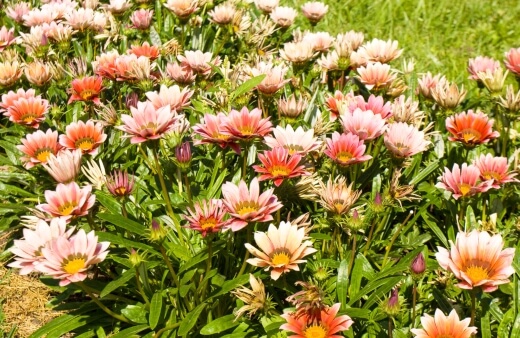
Best Conditions for Planting Gazanias
Soil Preference
Gazania grows best in poor soil, with excellent drainage, and will grow in the wild with next to no nutrients, often rooting into dusty cracks between rocks, or loose sand.
However, to improve their flowering display, mixing grit, sand, and compost together into containers can help boost their appeal as a flowering border perennial.
Watering Gazania
Gazania will rot away completely if they are overwatered, so other than watering them for the first few weeks to establish good root contact, they should only ever be watered during periods of extreme and extended drought.
Sunlight Needs
Plant gazania somewhere with at least 8 hours of direct sunlight per day in summer. Gazania grows in open ground and doesn’t like to be shaded by trees or shrubs.
Find a North facing spot where they get direct sun for as much of the day as possible.
Temperature
In cooler parts of Australia, any gazania should either be protected or treated as an annual, with regular yearly sowings. However, no Gazania species and cultivars are truly annual plants.
Provided the temperature doesn’t drop below 7°C, gazania will re-flower year after year. If temperatures can be kept over 10°C most species will even hold their foliage right through winter, though this is also affected by wet weather, which can rot off the top growth in autumn and winter.
Exposure
Extreme wind, salty air, or prolonged drought are fine for gazanias, which are mostly bred with coastal species genes for garden cultivars. This makes them incredibly tough. The only shelter they need is from frost, hail, and torrential rain.
How to Propagate Gazanias
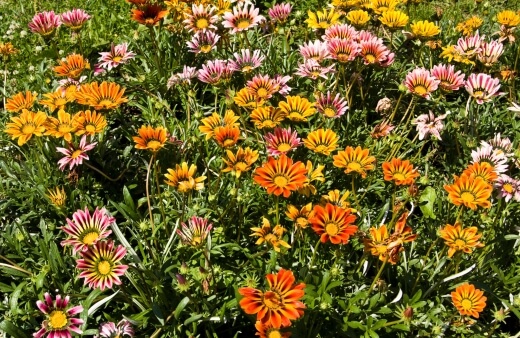
Propagating Gazanias from Seed
The best time to sow gazania is in spring when they benefit most from lengthening days and hotter weather but, in most of Australia, you can encourage an earlier flowering season by sowing them indoors in late winter, or even outdoors after any risk of frost has passed.
Tools:
- Sandy potting compost
- Seed tray
- 9cm pots
Indoor Method:
- In early spring or late winter, fill a seed tray with a loose, free-draining potting mix
- Thinly sow gazania seeds across the surface, but don’t cover
- Water them well
- Leave on a windowsill in full sun
- Germination takes 1-2 weeks
- Water seedlings when the soil begins to dry out, but do NOT soak them
- Once seedlings are large enough to handle (3-4 weeks), prick them out into individual 9cm pots
- Once roots have established in their individual pots, they are ready to plant in the garden
- Space young gazania plants 15-30cm apart. They will compete, but eventually bind into a single clump
Direct sowing:
- In mid-late spring, when all risk of frost has passed, prepare a bright bed, in full sun
- Remove any weeds, unwanted roots, and weed seedlings
- Ensure the soil is free draining but with some goodness (mix compost and horticultural sand in until its free draining, but hold some moisture)
- Rake the surface level
- Sow seeds 5-10cm apart, or loosely broadcast sow
- Water the ground well to create proper contact with the soil
- As seedlings germinate, thin them to 10cm apart
- Water seedlings regularly for the first 3-4 weeks
- Leave them to do their thing, and water once a week in dry conditions through summer
Gazania Propagation from Cuttings
Like any herbaceous perennial, gazania can be propagated from cuttings if you know how to treat it. Basal cuttings are the best way to take cuttings from gazania, choosing young growth in spring, and keeping a very small flick of root attached.
Learn more about basal and other ways to take plant cuttings here.
Tools:
- Sharp cutting knife
- Rooting hormone - Get the best rooting hormones available online here.
- 9cm plastic pots
- Perlite
- Potting compost
- Polythene bag
Method:
- In late spring, fill a 9cm pot with free-draining compost, with perlite mixed through as a 50:50 mix
- Find a healthy plant with plenty of new growth that hasn’t started forming flowers or buds
- Cut right down to the base of a healthy stem, keeping a small piece of root attached
- Dip the base in rooting hormone
- Gently insert four of these cuttings into the corners of the pot
- Cover with a clear polythene bag, and keep them indoors, reasonably moist, until new growth appears in a few weeks’ time
- When new growth starts, continue watering when the soil dries out and remove the polythene bag to reduce any fungal problems
How to Care for Gazanias
Gazania need very little ongoing care, but deadheading and feeding them can help to improve your annual display of brightly coloured blooms.
Avoid any temptation to mulch or water gazania through winter, even if their foliage dies back. The chances are that it will grow back next year, and is more likely to rot with overwatered or ground-cover mulches than without.
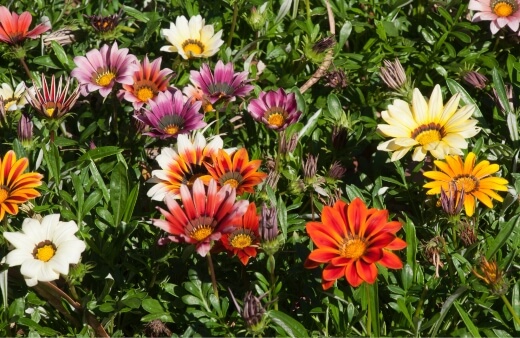
Best Fertiliser for Gazania
Any slow-release fertiliser is adequate for gazania. Remember that they don’t need nutrients in nature, and get everything from occasional rainfall, and minerals from sandy or rocky substrates.
To encourage more flowers you can add Osmocote for Potted Plants which will help rejuvenate missing minerals and nutrients in the soil.
Pruning and Repotting
Gazania doesn’t need pruning, but some trailing varieties will need to be separated and divided every 3-4 years to avoid becoming hollow in the centre. To divide clumps of gazania, simply dig out half a clump at a time, and replant it at the same level elsewhere in the garden.
The remaining clump will flower better that year, and the moved clump will take a year to establish, but grow into a strong (and free) plant the following year.
As gazania flowers fade, remove them individually to extend the flowering season and encourage new flowers.
Common Gazania Pests and Diseases
Gazania really are one of the easiest flowering ground cover plants to grow in Australia. Not only are they drought tolerant, and capable of thriving on poor soil, but they are rarely troubled by pests, and the only diseases they suffer from are caused by caring too much, rather than too little.
Slugs & Snails
Slugs & Snails are pretty much the only pests that regularly attack gazania, but if you’ve got a full garden with other options, slugs and snails will go elsewhere for food.
Gazania might be good-looking, but they clearly don’t taste that great, so the only pests that affect them are those that are starved of options.
Diseases Due to Overwatering Gazanias
If you overwater gazania, or water directly over the foliage in warm weather, they will almost certainly develop mildew or crown rot.
Root rot occurs over winter with gazania, as a result of watering during dormancy, or leaving them in a damp corner of the garden to suffer from more regular downpours.
In all cases, reducing watering, and removing any rotten growth (above and below ground) will usually recover the plant.
If you notice signs of crown or root rot on an established gazania clump, just dig up the bad bits, and replace the soil with a fresh mix to prevent re-infection. Dispose of dead or damaged materials.
Within a few months, your plant will have recovered and should fill out any empty patches quickly.
Gazania Frequently Asked Questions
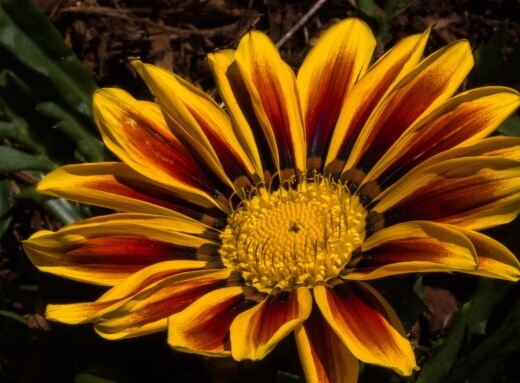
Should you deadhead gazania?
Gazania benefit from regular deadheading, which prevents the plant from producing seed and lengthens its flowering period. Every time you remove a flower, cut back to just above a leaf. This encourages new growth, bushier foliage, and future flowers.
Do gazanias come back every year?
Gazanias come back every year but are only half-hardy perennials, so do need to be protected from frost and damp winters. If they can be stored above 7°C they will bounce back into action in early spring.
Do gazanias spread?
Every Gazania species spreads in different ways, with some forming tight clumps that spread from thick roots, and others trailing across the ground and rooting along the stem.
In all cases Gazania are manageable, slow-spreading groundcover plants, and perfect for low-maintenance gardens.
How do you divide gazanias?
Gazanias couldn’t be simpler to divide. When a clump has outgrown its space, just shove a space right through the middle or the clump and dig it out.
You can reduce the size of the clump dramatically, often making 5-10 new small clumps to dot around the garden.
Grow Beautiful Gazanias in Your Garden
Gazanias are popular garden plants for a reason. These low-maintenance, high-reward perennials are incredibly easy to grow and fill gardens with bright, sunny blooms right through summer.
Their flowering season can be easily extended with regular deadheading, and they won’t add anything to your water bill. If we’ve not convinced you to grow gazania yet, I’m not sure what else we can do.
They are the perfect plant for every Australian garden, and now that you know how to grow gazania, there’s really no excuse not to.
Published on August 29, 2022 by Maisie Blevins
Last Updated on October 4, 2025





Gazanias are spreading on sandy soils in dryland paddocks. Similar to another Southetn Affrica invasive plant, Cape Weed.
Having just read about how invasive gazanias are in Australia I was rather shocked to find your website promoting them. Please read: https://www.theguardian.com/australia-news/2025/jul/06/gazania-daisies-invasive-species-council-australian-nurseries
G’day Stella, and thanks for getting in touch.
At Aussie Green Thumb, we pride ourselves on being responsible gardeners, and we truly hope fellow Aussies feel the same way. That means not just choosing the right plants, but also making sure they don’t escape into the wild and become a problem.
Personally, I’d agree that Agapanthus is another example worth rethinking. It’s often overlooked, but once it flowers and goes to seed, it can spread viciously, especially along roadsides and bush edges. It’s not officially declared invasive in all regions, but the way it takes over in many areas absolutely warrants more attention. Like many plants, it comes down to the grower taking responsibility for managing it properly, or better yet, choosing safer alternatives.
Now, regarding Gazania, you’re absolutely right to raise this. Some Gazania species and hybrids, especially Gazania rigens, have become seriously invasive in parts of Australia. They establish quickly in coastal and arid environments, push out native species, and are hard to control once naturalised.
We’ve read the article you shared from The Guardian (thank you for linking it) and we’re currently reviewing our site content to ensure we’re not promoting plants that pose a risk to Australia’s unique ecosystems. Our intention is always to share advice that supports sustainable and ecologically responsible gardening, so we’ll be updating our Gazania content to reflect current biosecurity concerns and guide readers toward better plant choices.
For anyone looking for colourful, drought-tolerant groundcovers with a similar appeal to gazanias but without the environmental risk, here are some excellent native alternatives:
Chrysocephalum apiculatum (Common Everlasting)
Scaevola aemula (Fan Flower)
Myoporum parvifolium (Creeping Boobialla)
Goodenia ovata (Hop Goodenia) — ideal for part shade
Thanks again for calling this out. It’s exactly the kind of conversation we need to have as a gardening community to protect what makes Australian landscapes so special.
Cheers,